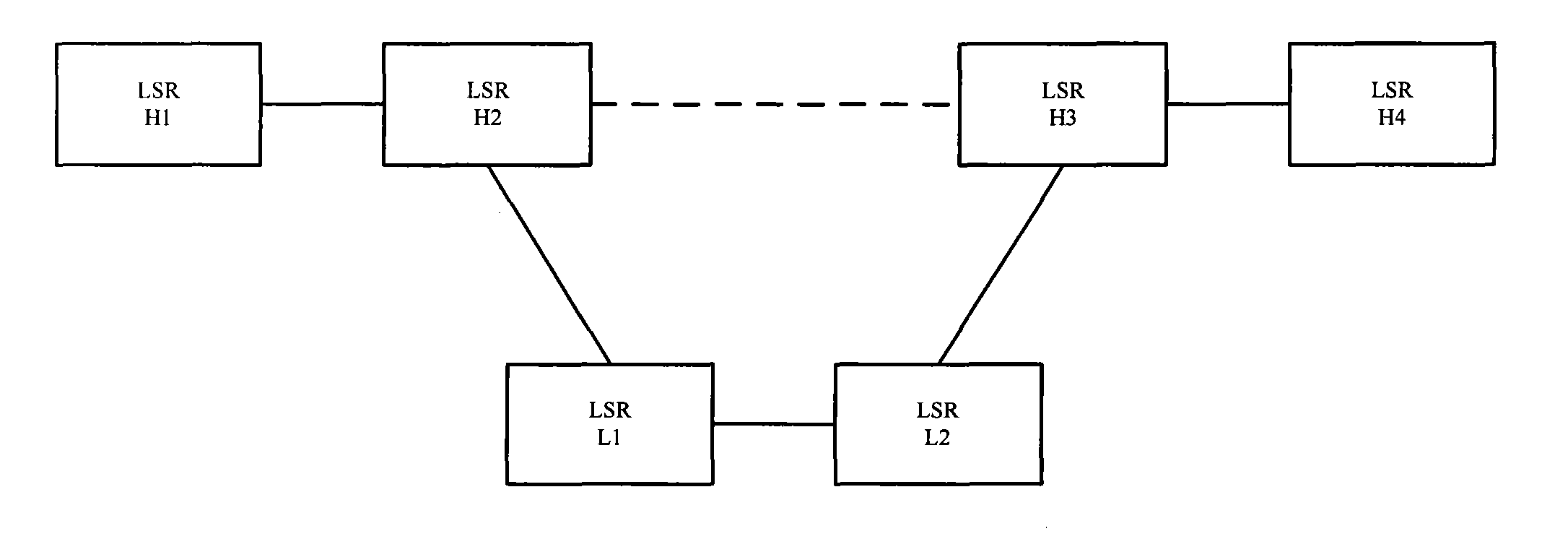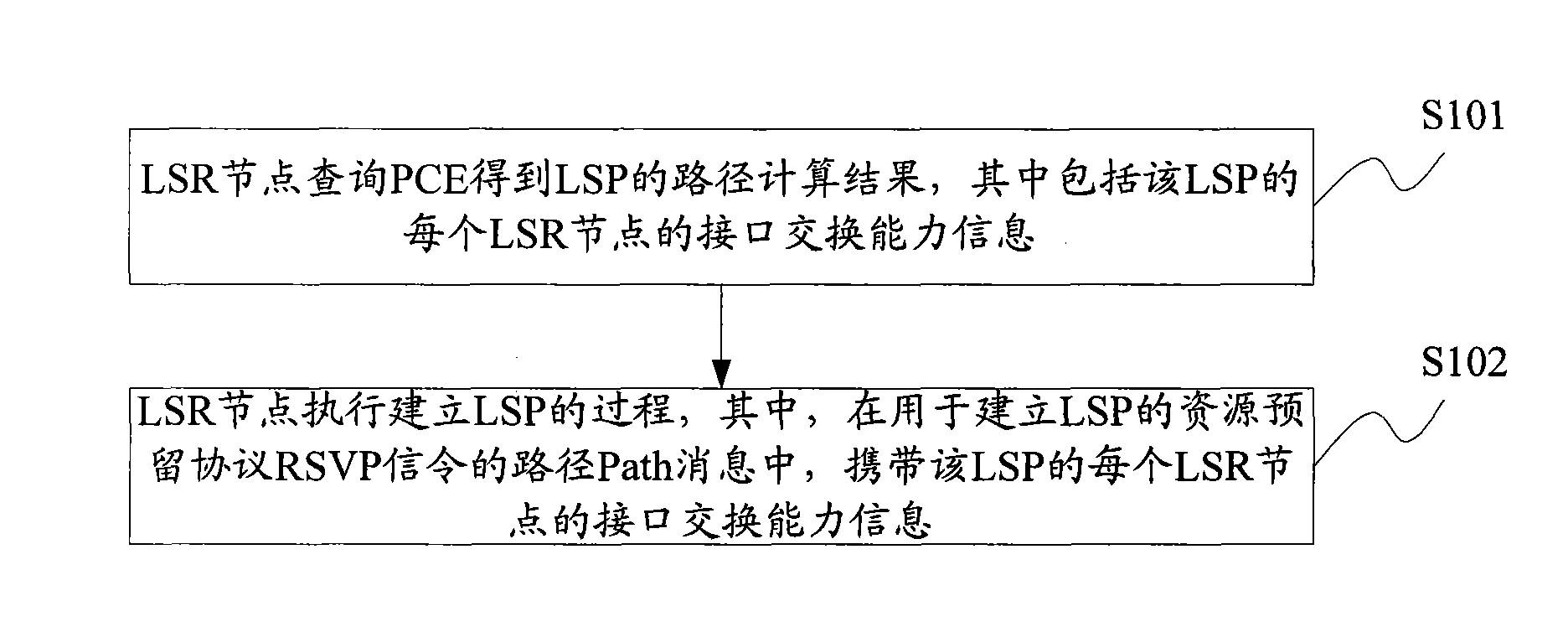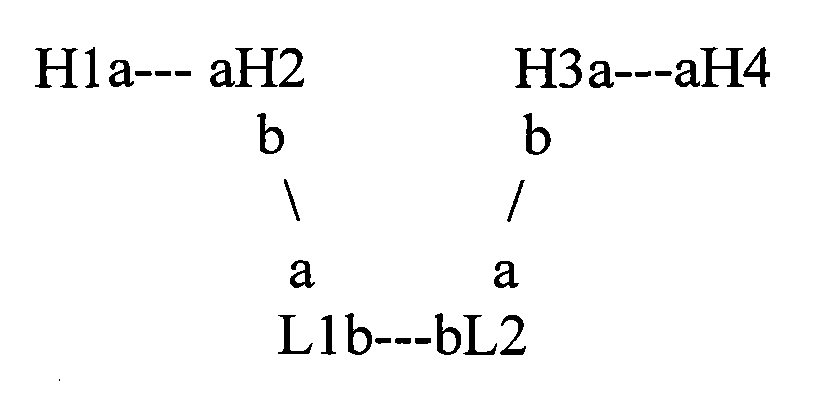Method, system and device for establishing label switch path
A label-switched path and establishment method technology, applied in the field of label-switched path establishment, can solve the problems of not providing an LSP boundary determination scheme, and being unable to automatically trigger the creation of lower-layer LSPs.
- Summary
- Abstract
- Description
- Claims
- Application Information
AI Technical Summary
Problems solved by technology
Method used
Image
Examples
Embodiment 1
[0090] see image 3 , the network shown in this figure includes two layers, H1, H2, H3, and H4 are LSR nodes of the upper layer network, and H2, L1, L2, and H3 are LSR nodes of the lower layer network. Among them, H2 and H3 are domain boundary nodes, and are also boundary nodes of the lower layer LSP. a and b represent the interfaces on the nodes. For example, in the figure, node H1 is connected to interface a (upstream interface) of H2 through interface a (downstream interface), and H2 is connected to interface a (upstream interface) of L1 through interface b (downstream interface). .
[0091] H1 requests to create an LSP from H1 to H4, H1 first sends a routing query request to PCE, PCE calculates the path from H1 to H4, and then returns the result to H1, and informs each ERO of the LSP and the interface of each ERO in the returned result Switchability and crossover granularity.
[0092] After H1 receives the PCE Rep message, it also carries the ERO object in the PC...
Embodiment 2
[0096] Embodiment 2 (the cross granularity information of the ERO object does not need to be carried in the PATH message):
[0097] Figure 4 The network shown consists of three layers, and the establishment of nested LSPs, where H1, H2, H3, and H4 are the LSR nodes of the upper layer network, M1, M2 are the LSR nodes of the lower layer network, and L1, L2 are the lower layer network LSR nodes.
[0098] H1 requests to create an LSP from H1 to H4, H1 first sends a routing query request to PCE, PCE calculates the path from H1 to H4, and then returns the result to H1, and informs each ERO of the LSP and the interface of each ERO in the returned result exchange capacity.
[0099] After H1 receives the PCE Rep message, it carries the ERO object and its sub-object Switching Type in the PCE Rep message in the Path message.
[0100] The head node H1 analyzes the ERO object and its Switching Type sub-object carried in the Path message, and determines that the switching ca...
Embodiment 3
[0104] Figure 5 Shown is a scenario where LSPs traverse multiple lower-layer networks, where H1, H2, H3, and H4 are upper-layer network nodes, and L1, L2, L3, and L4 are lower-layer network LSR nodes, where L1, L2, L3, and L4 can be the same An LSR node of a network of one switching type, or an LSR node of a network of a different switching type.
[0105] H1 requests to create an LSP from H1 to H4, H1 first sends a routing query request to PCE, PCE calculates the path from H1 to H4, and then returns the result to H1, and informs each ERO of the LSP and the interface of each ERO in the returned result Switchability and crossover granularity.
[0106] After H1 receives the PCE Rep message, it carries the ERO object and its sub-objects Switching Type and Traffic Parameters in the PCE Rep message in the Path message.
[0107] The first node H1 analyzes the ERO object carried in the Path message and its Switching Type and TrafficParameters sub-objects, and determines th...
PUM
 Login to View More
Login to View More Abstract
Description
Claims
Application Information
 Login to View More
Login to View More - R&D
- Intellectual Property
- Life Sciences
- Materials
- Tech Scout
- Unparalleled Data Quality
- Higher Quality Content
- 60% Fewer Hallucinations
Browse by: Latest US Patents, China's latest patents, Technical Efficacy Thesaurus, Application Domain, Technology Topic, Popular Technical Reports.
© 2025 PatSnap. All rights reserved.Legal|Privacy policy|Modern Slavery Act Transparency Statement|Sitemap|About US| Contact US: help@patsnap.com



